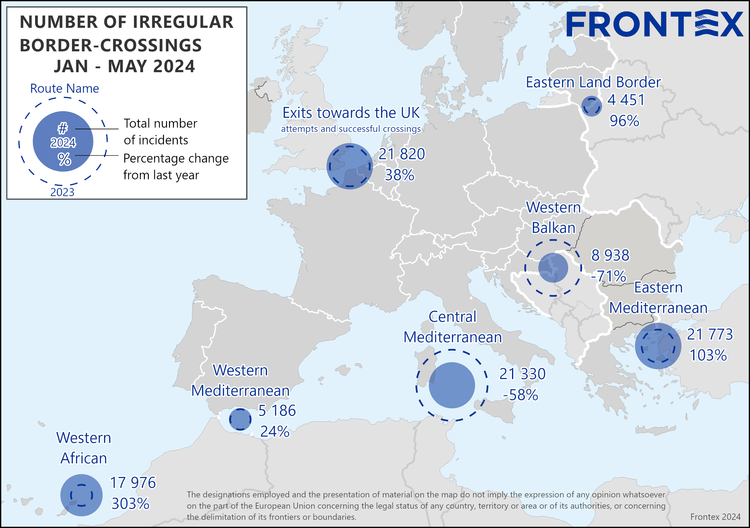The number of irregular border
crossings into the European Union in the first five months of 2024 fell by
nearly a quarter (23%) to nearly 80 000, according to preliminary data collected
by Frontex. The Western Balkans and Central Mediterranean saw the biggest drops
in detections of irregular crossings among the major migratory routes (-71% and
-58%, respectively), while the Western African and Eastern Mediterranean routes
experienced the highest increases (+303% and +103%, respectively).
Key highlights for the first five months of 2024 include:
- Central
Mediterranean saw a 58% drop (y/y) in detections.
- Western
Balkans also continued to see significantly lower numbers (-71%), biggest drop
among major migratory routes into the EU.
- The Western
African route recorded the largest rise.
- Eastern
Mediterranean was the most active migratory route, with arrivals doubled.
- Eastern
Land Border sees significant rise in detections from a year ago
- Top three
nationalities on all routes this year: Syria, Mali, Afghanistan.
The Central Mediterranean
route, which saw the largest number of irregular crossings in 2023, continued
to show a downward trend from recent months, with a year-on-year drop of 58% to
slightly above 21 300 in the first five months of 2024. In the month of May,
the number of arrivals stood at nearly 5 100, down nearly 37% from a year ago.
Also in line with the recent
downward trend, the number of detections on the Western Balkan route in
the January-May period fell 71%) to just over 8 900.
Meanwhile, the Western African
route continued to see unprecedented numbers of detections, with number of
irregular migrants reaching the Canary Islands in the first five months of the
year rising 303% from the same period of last year to nearly 18 000. This was
the highest total for this period since Frontex began collecting data in 2011.
In May, the number of arrivals stood at 2100.
The most active migratory route
in the January-May period was the Eastern Mediterranean, with the number
of detections more than doubling to over 21 200 in the first five months of the
year.
Frontex remains committed to
safeguarding the EU's borders, with 2800 officers and staff engaged in various
operations.
Sea crossings remain fraught with
peril for the people undertaking irregular migration. Data from the
International Organization for Migration (IOM) indicates that 923 individuals
have been reported missing in the Mediterranean so far this year. The vast majority
of them were navigating the perilous Central Mediterranean route.
In the first five months of 2024,
there was also a significant increase in irregular border crossings at the Eastern
Land Borders, with numbers nearly doubling to 4 450 compared to the same
period last year. This increase, while notable, still represents the least
active migratory path into the EU among the major routes. However, recent
trends suggest that the Eastern Land route is becoming more active, approaching
the figures seen on the Western Mediterranean route. The rise in numbers is
largely attributed to heightened activity at the border with Belarus, which has
seen an increase in attempted crossings, often facilitated by Belarusian
authorities. Additionally, on the Ukrainian border, irregular crossings are
primarily carried out by Ukrainian citizens circumventing border checks.
On the Channel route, the number of detections in the first five months of 2024 increased 38% to21 820.
Note: The preliminary
data presented in this statement refer to the number of detections of irregular
border crossing at the external borders of the European Union. The same person
may cross the border several times in different locations at the external border.

